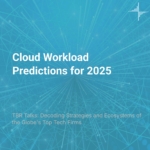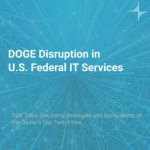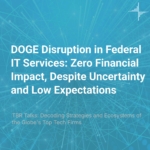Cloud Workload Predictions for 2025

What challenges will IT decision makers face in the current macroeconomic environment and amid the need to manage enterprise data, workload migration and ongoing services? In this episode, titled “Cloud Workflow Predictions for 2025,” TBR Principal Analyst Allan Krans shares his analysis of and predictions for cloud market share in 2025, including expectations for generative AI (GenAI) spend and the impact the technology will have on the market.
Patrick and Allan also dig deeper into anticipated ROI for recent GenAI investments, compared to more common digital transformation engagements for cloud players such as Microsoft’s Azure, Amazon Web Services and Google Cloud Platforms
Listen and learn with TBR Talks!
Submit your Key Intelligence Questions for Patrick and his guests
Connect with Patrick on LinkedIn
Connect with Allan on LinkedIn
Connect with Chris on LinkedIn
Learn more about TBR at https://tbri.com/
TBR Talks is produced by Technology Business Research, Inc.
Edited by Haley Demers
Music by Burty Sounds via Pixabay
Art by Amanda Hamilton Sy
Cloud Workload Predictions for 2025
TBR Talks Host Patrick Heffernan: Welcome to TBR Talks, Decoding Strategies and Ecosystems of the Globe’s Top Tech Firms, where we talk business model disruption in the broad technology ecosystem from management consultancies to systems integrators, hyperscalers to independent software vendors, telecom operators to network and infrastructure vendors and chip manufacturers to value added resellers. We’ll be answering some of the key intelligence questions we’ve heard from executives and business unit leaders among the leading professional IT services and telecom vendors.
I’m Patrick Heffernan, Principal Analyst, and today we’ll be talking about 2025 predictions for Cloud Market Share with Alan Krans, Principal Analyst for TBR Cloud and Software Practice.
GenAI ROI skepticism
Allan, thanks for coming in, always good to chat about predictions for 2025, what you thought in 2024 which now as we get into 2025, you might be changing your mind already. We’ll see. We’ll find out. I’m curious, having read the predictions document that that you put out last month, there was some skepticism around the return on investment on generative AI. And I’m curious if that skepticism that runs across the entire ecosystem, including the clients, is that fueled by some overspending on earlier technologies? Is it a result of sort of the relentless hype around generative AI in 2023 and 2024? Is it a realization that most enterprise’s data is just too messy to get a return quickly? Like, what’s the biggest reason why there’s this persistent skepticism around the return on investment?
Allan Krans, TBR Principal Analyst: Sure. Yeah. And I think it’s a lot of those things rolled all up into one. And so kind of starting with the general landscape of buyers in, you know, late 2022 going into 2023, looking at cost optimization. Right. A lot of uncertainty in their markets and geopolitical situations. And so that makes saving money, spending less, really top of mind. And so, with the cloud market, you know, when it was first growing, it was such a small portion that it was a cost saver. It was a way to reduce IT expenses, but that’s no longer the case. It’s such a large portion of most enterprise IT budgets that if you’re going to save money overall, you have to look at optimizing the cloud environment. And so, a lot of the generative AI has inherited this, you know, focus on cost. Really looking at the financial metrics for the justification for these investments. And so that’s kind of leading in, you know, what’s- leading to some hesitancy around large investments. That’s the other thing. It’s tough to really get enterprise production use cases for GenAI without not only spending a lot on the technology itself, whether that’s provided from a cloud provider, whether that’s going to be something that’s on prem. And obviously there’s a lot of infrastructure and facility costs that go into that. You know, to really get those financial returns requires a bit of a leap of faith. And it’s in some ways tough to ask enterprises to go forward with that when there’s a lot of economic uncertainty for them.
And then also there’s the general shift in terms of how are we going to manage it? Do we have the skills to do this properly? Are we secure? And then dealing with the state of the data that already most enterprises would have said, we need to do a refactoring, a data cleanse, to make sure that we’re not just getting outputs that are resulting from improper data management practices. So, there’s a big investment there in terms of the underlying data that will be used in this, in order to really get the best out of it.
And so, you know, with all that said, a lot of enterprises felt like they had to move early.
Patrick: Right
Allan: And get started with it. And so they’ve done that. They’ve spent, in some cases, you know, pretty significant increases from other areas of the budget, thinking of it, kind of in an R&D, a way to kind of secure their, place in this new world where AI is going to fuel a lot of business processes and help them automate and make better decisions, and part of the issue with those early use cases is there’s a kind of gray area of return where just because you’re more productive doesn’t mean that you’re going to either realize more revenue or be able to reduce your expenses in certain operational areas.
Longer term, I think there’s a large promise in terms of what it can deliver to enterprises. It’s going to take a long time to get there. And so, I think there is this kind of trough of, you know, looking at the early investments, but thinking that they’re going to need to do a lot more over the long term. And that’s, a little bit daunting when you start to think about the change that that brings.
Patrick: Yeah. And so, you said a couple things there that we’re so used to in the technology space, like talking about use cases, talking about investment, talking about long term, talking about the way that, cloud maybe was a necessary investment and a cost saver initially and at some point it hit an inflection point. You also said a couple things that we never talk about in technology. Leaps of faith, like that does not often happen. And then also, I love the idea of a gray area on return on investment because I think that’s what we’ve seen more than anything else where a lot of companies have been looking for. What’s the percentage of productivity improvement that I’m going to get? What’s the percentage of cost savings I’m going to see? And early on, those use cases at scale, at least they’re not proving that out.
Cloud vendors’ future GenAI investment
But all of that skepticism aside, or maybe, thinking even through all of that skepticism. In the report, you make the case that the cloud vendors themselves are continuing to invest very heavily. They see the future of GenAI, perhaps better than their enterprise customers do. Is there is there a particular reason for that, or is it just simply that’s the big bet that they’ve all made?
Allan: I mean, I think that’s the big bet that they feel is going to be the future of growth in the cloud market. When you think about net new workloads, you know, we’ve been through a lot of enterprises have moved what they feel like is an appropriate workload into cloud already. So, there’s some growth in terms of additional usage, as you know, there’s more data, there’s more transactions. However, you know, you get addicted to that big bump of, the next SAP environment, the next big workload. There’s a dearth of those now, and so GenAI is one big workload that the cloud providers can monetize. And it matches well with the scale of what they can make in terms of investments because there’s different data centers, different environments, very expensive processors and infrastructure that need to go in to support that. And so, they’re on a scale where they can do that, a lot of the even large enterprises, it’s a big commitment from them. Certainly, for the SMB and smaller customers, you know, they’re just never going to be hosting their own GenAI model doing the training and everything that they need to do to do it themselves. So, it will drive demand for hosted services from the cloud providers, to kind of GenAI capabilities out there in mass to the entire market.
Patrick: So, they can see that demand coming, so they’re willing now to invest, to invest heavily in things like infrastructure to the point of, you know, nuclear power plants and stuff like that. I mean, it’s kind of shocking the way that that part of the market has changed in the last couple of years. We did not three years ago talk about Microsoft and AWS and Google like building their own little mini nuclear power plants. But that’s where we are now.
Allan: Yeah. I mean, it’s pointed out the bottleneck in the supply or for how to deliver this at scale. Energy is a huge factor. There’s all of the commitments around carbon reduction and meeting those commitments environmentally that it’s causing stress to. So, I think it forces vendors to get creative and nuclear certainly is part of that.
Microsoft and AWS
Patrick: So, another thing you point out, one of the big predictions in the report is about Microsoft and AWS. And you make the case that Microsoft will surpass AWS in revenue in 2027. So, my question reading that is then, okay, Microsoft will surpass AWS in 2027 unless AWS does, fill in that blank, does what?
Allan: I think changes the landscape for the GenAI portion of the market. If they can, you know, capitalize- so, instead of being as beholden and partnered with OpenAI, they’ve been doing a lot with their own innovation with being open to multiple model providers. So that’s been their best strategy to date. Microsoft had an early advantage with their partnership and investment in OpenAI, and so that’s propelled them to some degree.
They were already growing faster than AWS.
Patrick: Yeah.
Allan: I think it’s, you know, part of their kind of broader set of capabilities around the, Software as a Service side of the market, being able to leverage that from a go-to-market model. The partner distribution has been part of their strong suit for the entirety of their business, and so that portion of the go to market is really caught up and is propelling them a little bit faster than AWS. We do expect to see kind of a refocusing of the sales strategy from AWS as they’ve had a change in leadership and really start to look at driving a go-to-market model that relies on an ecosystem, and is really pragmatic about where they’re investing rather than just, you know, growing because they were the earliest cloud platform in the cloud space.
Corporate cultural shift
Patrick: Right. How much of that is a culture change? And I’m asking that question knowing full well that here at TBR we’re all about the data, we’re all about looking at the numbers. We’re all about looking at the financial performance, and we’re all about looking at, you know, analyzing in a- not in a wishy-washy way, but in an analytical way. And yet when you talk about culture, sometimes corporate culture, sometimes you get into something that’s a little hard to measure. But is there going to need to be a cultural shift in AWS for them to either maintain their lead or at least not get surpassed in a meaningful way?
Allan: Yeah, and I think we’ve already seen that. I think a slowdown in growth will cause you to look inward pretty quickly. And so culture is going to be something that is adjusted as they look to, you know, optimize their financial performance and they can’t keep with the same sales and marketing strategy that was good for them, you know, for the early onset. There needs to be a shift. And so, I think the performance is causing them to take a look and start, you know, you already see it with the leadership.
Patrick: Yeah.
Allan: Looking at, someone who’s focused on sales and marketing rather than innovation or just being, you know, part of the retail side of the business. So, it is a fresh perspective.
Repatriation
Patrick: So, I’m going to go a little bit out, away from what we normally talk about when we’re talking about cloud and hyperscalers and all that, except it’s a question that comes up on the services side in particular, where the question is, what kind of workloads are going to get repatriated back to on prem, and in the predictions report you mentioned that briefly and you basically dismiss it. And I’m curious, is that where you think it’s going to go? There’s never going to be like significant portion of the workloads that get repatriated back to on prem, based on everything you’ve talked about, especially when you when you mentioned sort of the vast investments the cloud companies have to make in terms of being able to provide for SMBs and others that aren’t going to have it. If the option is, instead of going with Azure and putting it, putting- running your GenAI miles on the cloud, is repatriation a real issue or is it just going to remain a tiny percentage?
Allan: I think it’s going to be a small percentage. I think the situations where it makes sense, a lot of times it has somewhat to do with the workloads. If there’s a stable workload that you believe isn’t going to change over the next 5 to 10 years so the environment can remain consistent. You can run it. And if the focus is on cost, and you have the internal IT resources and team to feel like something that you can manage and deploy on prem, you can do it cheaper.
Patrick: Yeah.
Allan: And so, for organizations where that’s important or for things that are big enough that makes a big impact in terms of the overall level of spending, I think that’s where you’ll see it. I also think that in most cases, those are the workloads that wouldn’t have gone to the cloud in the first place. So, part of it could be you go back to culture, if there was a cultural shift. Cloud first, cloud, everything. If you know, as that changes and you get new leadership that takes more of a financial or a traditional look at the IT strategy. Yeah.
Patrick: Okay.
Allan: We will see that, but I think it’ll be, you know, in the single digits.
Use cases
Patrick: Yeah, it’ll remain small on that, and that’s important. If you’ve sort of made the mistake of sending something to the cloud that then you realize you need to bring it back, but you need to bring it back under the right conditions, where like you said, you have the you have the infrastructure in place and you also have the people in place to be able to handle it.’
All right, last question, and to get back to sort of the big GenAI picture, one thing we hear again and again- the question is always what are the use cases that are resonating with clients? Whatever, it depends on the client. It depends on their industry. It depends on their size. Blah blah blah.
The other thing that I think is more interesting, are what are the use cases that you have heard about, maybe at a pilot level or maybe even a, you know, just proof of concept level that you think, okay, in 2025, these are the use cases- this use case is going to explode because it’s truly innovative. It truly addresses a business problem in a way that AI hasn’t addressed before. Or it just sounds cool. Like what are the- what’s a use case that has kind of has jumped out at you in the last couple months that you think will be significant, that people will be talking about by the end of 2025. Allan: Sure. Yeah. So, I think there’s a lot- it gets very nuanced. So, it gets focused down on the industry. One thing that was kind of interesting that I just heard about is automated vehicle inspections. So, in New Hampshire we go through a physical inspection of the vehicle every year.
Patrick: Right.
Allan: With a mechanic and every garage does them for a certain fee. This uses, computer vision, so a combination of a visual inspection as well as mining the data from the vehicle to not just do a “well, you need to fix this or that” to kind of do a holistic view of the state of the vehicle. So, that was kind of an interesting thing. And I think there’s a lot of other- you could go into real estate and other ways of combining different inputs, data, visuals, could be temperature. So much data could be mined. And then to have- a little bit novel. So, what’s the return on that? It’s a bit difficult to tell, but, things like that where it gets really down into the specific industry, are some of the things where there will be markets. And so being able to provide a solution that can be used by the entire industry and having that scale, I think, provides some of the promise for not just, a novel solution, but something that can really be a standard across multiple different markets and actually have a viable business model.
Patrick: And it all depends on the data, to get back to the sort of data is messy and then certain enterprises are not prepared to cope with that. And then the data has to go somewhere, be stored somewhere, or be analyzed somewhere, spit back out somewhere. And that requires again, we’re back to the nucelar power plant.
Allan: Yeah. Right. All those things.
Final thoughts
Patrick: Alan, thank you very much for coming in. Really appreciate it. We will chat again I’m sure in a few months.
Allan: Sounds great. Thanks.
Patrick: Next week I’ll be speaking with TBR SVP Dan Demers about TBR 2025 predictions for Generative AI. Don’t forget to send us your key intelligence questions on business strategy, ecosystems, and management consulting through the form in the show notes below. Visit tbri.com to learn how we help tech companies large and small, answer these questions with the research, data and analysis my guests bring to this conversation every week.
Once again, I’m your host, Patrick Heffernan, Principal Analyst at TBR, thanks for joining us and see you next week.
TBR Talks: Decoding Strategies and Ecosystems of the Globe’s Top Tech Firms
Join TBR Principal Analyst Patrick Heffernan weekly for conversations on disruptions in the broader technology ecosystem and answers to key intelligence questions TBR analysts hear from executives and business unit leaders among top IT professional services firms, IT vendors, and telecom vendors and operators.
“TBR Talks” is available on all major podcast platforms. Subscribe today!

 Technology Business Research, Inc.
Technology Business Research, Inc. Technology Business Research, Inc.
Technology Business Research, Inc. Technology Business Research, Inc.
Technology Business Research, Inc.